Research Proposal: Leadership's Impact on Employee Performance, Saudi
VerifiedAdded on 2020/06/06
|14
|4207
|53
Report
AI Summary
This research proposal explores the impact of leadership on employee performance and well-being within the Saudi Arabian tourism sector, focusing on the Saudi Commission for Tourism and National Heritage. It aims to identify the roles of effective leaders, the relationship between leadership and employee performance, and the strategies leaders employ to enhance employee output. The proposal includes research questions, a hypothesis, aims and objectives, a literature review, and a proposed research methodology. The literature review covers key concepts such as leadership styles, employee motivation, and organizational goals. The research intends to identify gaps in existing research and recommend ways to improve leadership practices within the organization. The study also highlights the importance of leadership in fostering employee engagement, trust, and a positive work environment, ultimately contributing to organizational success. A Gantt chart is included in the proposal to show the timeline of the research. The research will explore the impact of leaders on their employees and the overall performance of the organization.
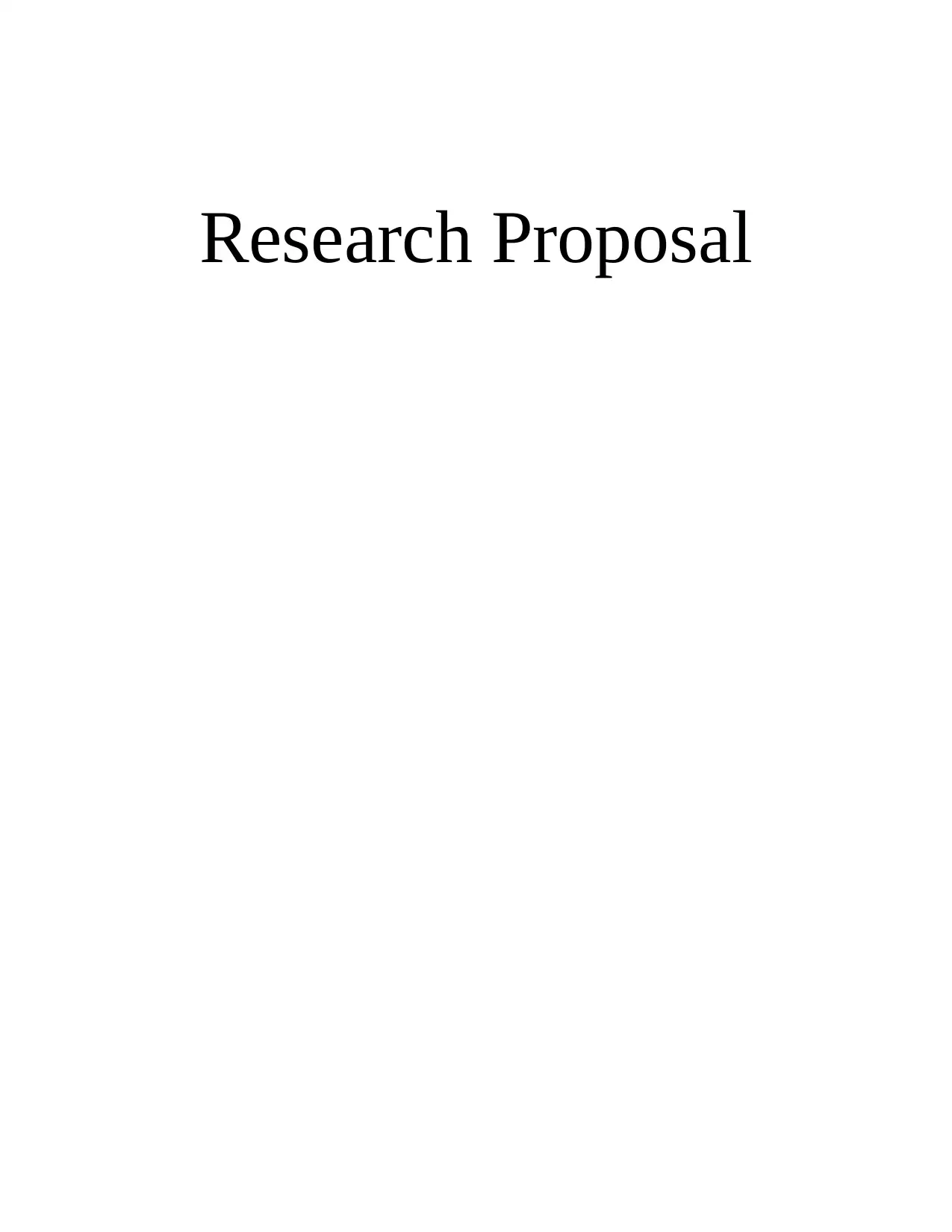
Research Proposal
Paraphrase This Document
Need a fresh take? Get an instant paraphrase of this document with our AI Paraphraser
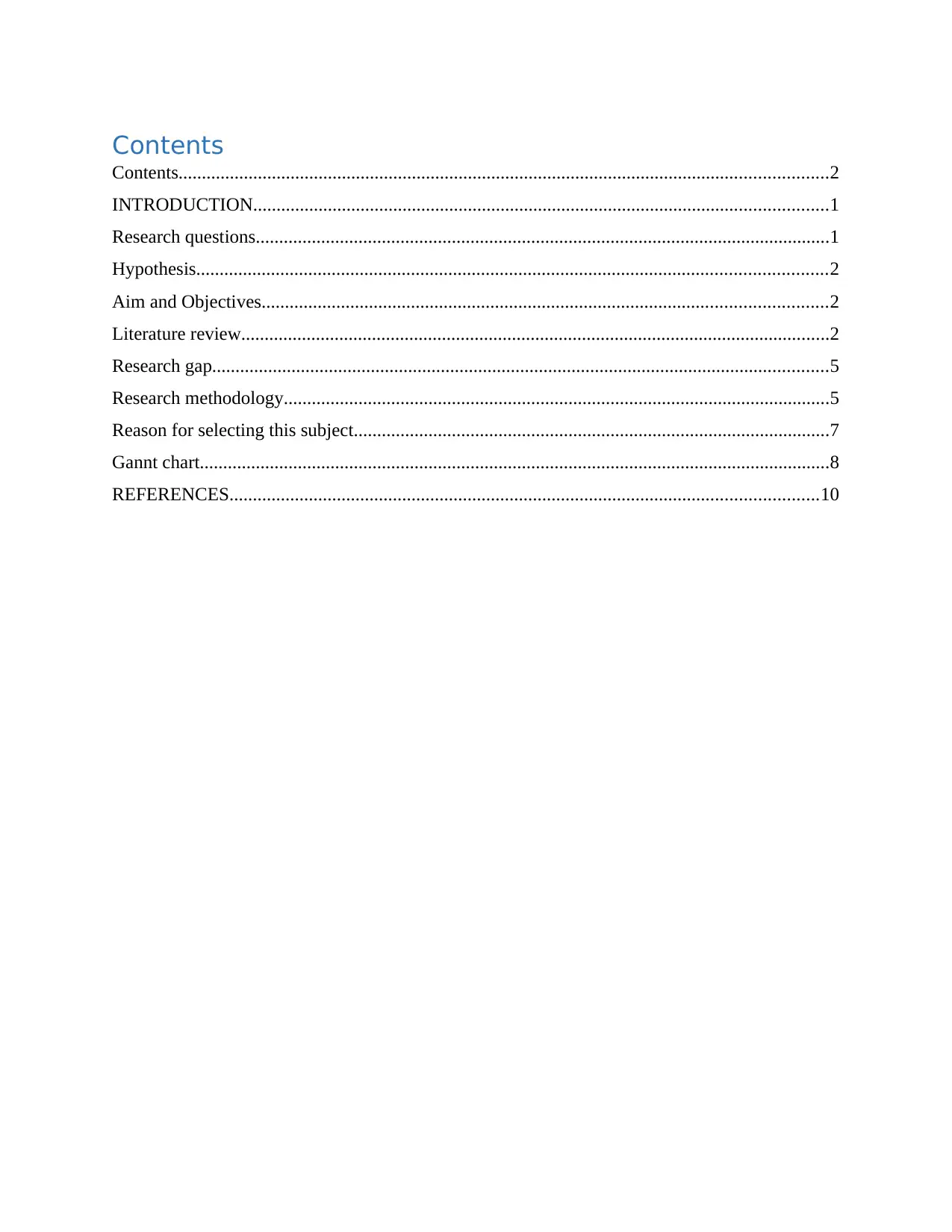
Contents
Contents...........................................................................................................................................2
INTRODUCTION...........................................................................................................................1
Research questions...........................................................................................................................1
Hypothesis.......................................................................................................................................2
Aim and Objectives.........................................................................................................................2
Literature review..............................................................................................................................2
Research gap....................................................................................................................................5
Research methodology.....................................................................................................................5
Reason for selecting this subject......................................................................................................7
Gannt chart.......................................................................................................................................8
REFERENCES..............................................................................................................................10
Contents...........................................................................................................................................2
INTRODUCTION...........................................................................................................................1
Research questions...........................................................................................................................1
Hypothesis.......................................................................................................................................2
Aim and Objectives.........................................................................................................................2
Literature review..............................................................................................................................2
Research gap....................................................................................................................................5
Research methodology.....................................................................................................................5
Reason for selecting this subject......................................................................................................7
Gannt chart.......................................................................................................................................8
REFERENCES..............................................................................................................................10
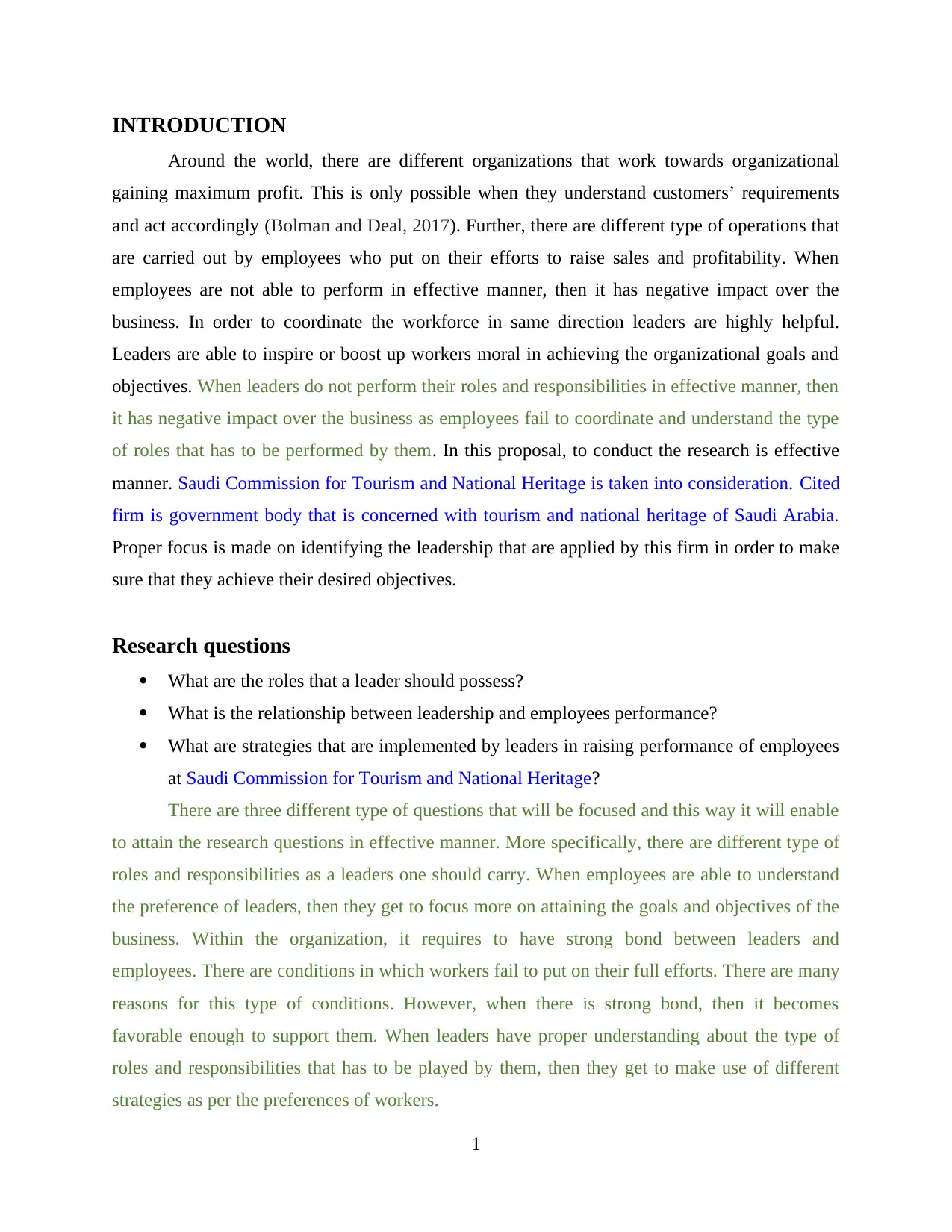
INTRODUCTION
Around the world, there are different organizations that work towards organizational
gaining maximum profit. This is only possible when they understand customers’ requirements
and act accordingly (Bolman and Deal, 2017). Further, there are different type of operations that
are carried out by employees who put on their efforts to raise sales and profitability. When
employees are not able to perform in effective manner, then it has negative impact over the
business. In order to coordinate the workforce in same direction leaders are highly helpful.
Leaders are able to inspire or boost up workers moral in achieving the organizational goals and
objectives. When leaders do not perform their roles and responsibilities in effective manner, then
it has negative impact over the business as employees fail to coordinate and understand the type
of roles that has to be performed by them. In this proposal, to conduct the research is effective
manner. Saudi Commission for Tourism and National Heritage is taken into consideration. Cited
firm is government body that is concerned with tourism and national heritage of Saudi Arabia.
Proper focus is made on identifying the leadership that are applied by this firm in order to make
sure that they achieve their desired objectives.
Research questions
What are the roles that a leader should possess?
What is the relationship between leadership and employees performance?
What are strategies that are implemented by leaders in raising performance of employees
at Saudi Commission for Tourism and National Heritage?
There are three different type of questions that will be focused and this way it will enable
to attain the research questions in effective manner. More specifically, there are different type of
roles and responsibilities as a leaders one should carry. When employees are able to understand
the preference of leaders, then they get to focus more on attaining the goals and objectives of the
business. Within the organization, it requires to have strong bond between leaders and
employees. There are conditions in which workers fail to put on their full efforts. There are many
reasons for this type of conditions. However, when there is strong bond, then it becomes
favorable enough to support them. When leaders have proper understanding about the type of
roles and responsibilities that has to be played by them, then they get to make use of different
strategies as per the preferences of workers.
1
Around the world, there are different organizations that work towards organizational
gaining maximum profit. This is only possible when they understand customers’ requirements
and act accordingly (Bolman and Deal, 2017). Further, there are different type of operations that
are carried out by employees who put on their efforts to raise sales and profitability. When
employees are not able to perform in effective manner, then it has negative impact over the
business. In order to coordinate the workforce in same direction leaders are highly helpful.
Leaders are able to inspire or boost up workers moral in achieving the organizational goals and
objectives. When leaders do not perform their roles and responsibilities in effective manner, then
it has negative impact over the business as employees fail to coordinate and understand the type
of roles that has to be performed by them. In this proposal, to conduct the research is effective
manner. Saudi Commission for Tourism and National Heritage is taken into consideration. Cited
firm is government body that is concerned with tourism and national heritage of Saudi Arabia.
Proper focus is made on identifying the leadership that are applied by this firm in order to make
sure that they achieve their desired objectives.
Research questions
What are the roles that a leader should possess?
What is the relationship between leadership and employees performance?
What are strategies that are implemented by leaders in raising performance of employees
at Saudi Commission for Tourism and National Heritage?
There are three different type of questions that will be focused and this way it will enable
to attain the research questions in effective manner. More specifically, there are different type of
roles and responsibilities as a leaders one should carry. When employees are able to understand
the preference of leaders, then they get to focus more on attaining the goals and objectives of the
business. Within the organization, it requires to have strong bond between leaders and
employees. There are conditions in which workers fail to put on their full efforts. There are many
reasons for this type of conditions. However, when there is strong bond, then it becomes
favorable enough to support them. When leaders have proper understanding about the type of
roles and responsibilities that has to be played by them, then they get to make use of different
strategies as per the preferences of workers.
1
⊘ This is a preview!⊘
Do you want full access?
Subscribe today to unlock all pages.

Trusted by 1+ million students worldwide
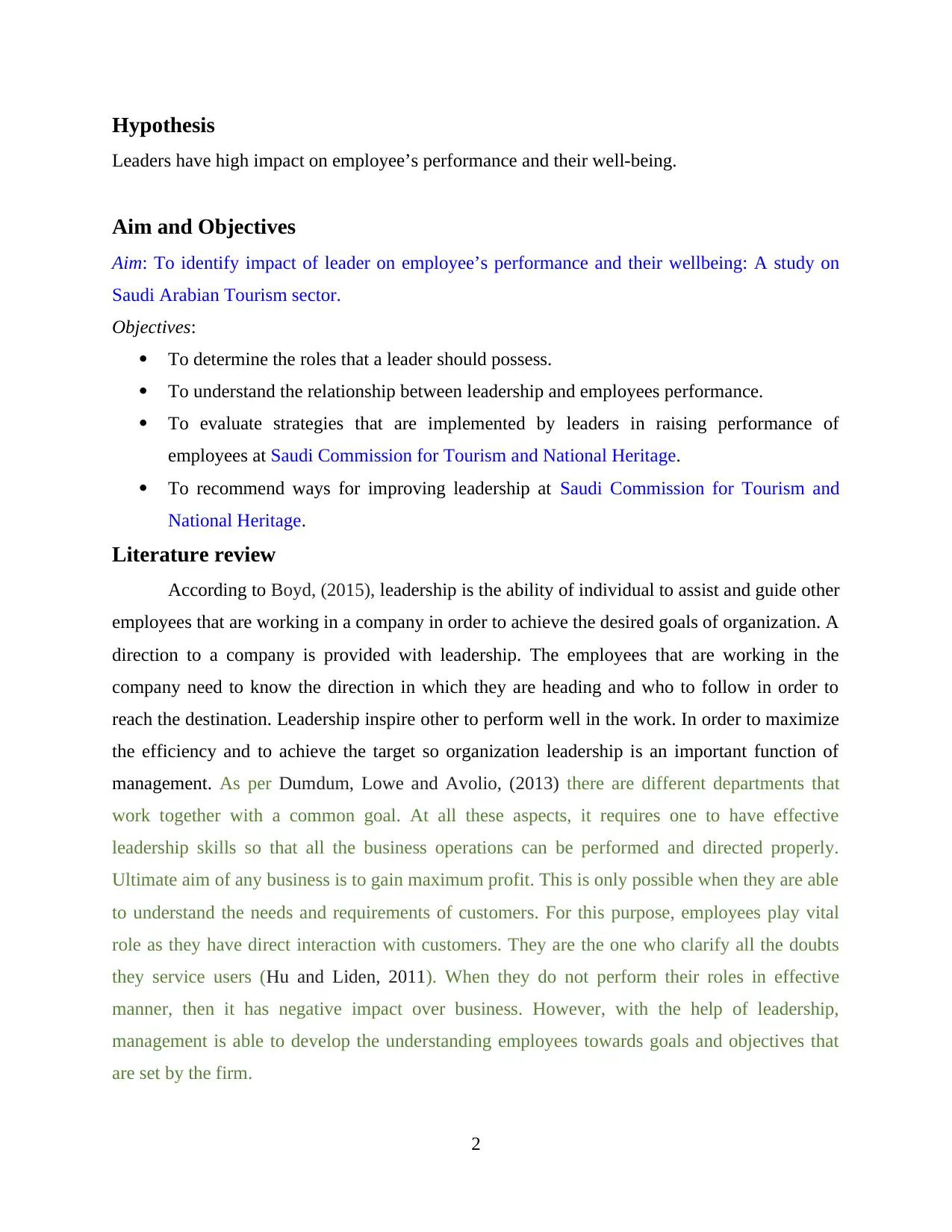
Hypothesis
Leaders have high impact on employee’s performance and their well-being.
Aim and Objectives
Aim: To identify impact of leader on employee’s performance and their wellbeing: A study on
Saudi Arabian Tourism sector.
Objectives:
To determine the roles that a leader should possess.
To understand the relationship between leadership and employees performance.
To evaluate strategies that are implemented by leaders in raising performance of
employees at Saudi Commission for Tourism and National Heritage.
To recommend ways for improving leadership at Saudi Commission for Tourism and
National Heritage.
Literature review
According to Boyd, (2015), leadership is the ability of individual to assist and guide other
employees that are working in a company in order to achieve the desired goals of organization. A
direction to a company is provided with leadership. The employees that are working in the
company need to know the direction in which they are heading and who to follow in order to
reach the destination. Leadership inspire other to perform well in the work. In order to maximize
the efficiency and to achieve the target so organization leadership is an important function of
management. As per Dumdum, Lowe and Avolio, (2013) there are different departments that
work together with a common goal. At all these aspects, it requires one to have effective
leadership skills so that all the business operations can be performed and directed properly.
Ultimate aim of any business is to gain maximum profit. This is only possible when they are able
to understand the needs and requirements of customers. For this purpose, employees play vital
role as they have direct interaction with customers. They are the one who clarify all the doubts
they service users (Hu and Liden, 2011). When they do not perform their roles in effective
manner, then it has negative impact over business. However, with the help of leadership,
management is able to develop the understanding employees towards goals and objectives that
are set by the firm.
2
Leaders have high impact on employee’s performance and their well-being.
Aim and Objectives
Aim: To identify impact of leader on employee’s performance and their wellbeing: A study on
Saudi Arabian Tourism sector.
Objectives:
To determine the roles that a leader should possess.
To understand the relationship between leadership and employees performance.
To evaluate strategies that are implemented by leaders in raising performance of
employees at Saudi Commission for Tourism and National Heritage.
To recommend ways for improving leadership at Saudi Commission for Tourism and
National Heritage.
Literature review
According to Boyd, (2015), leadership is the ability of individual to assist and guide other
employees that are working in a company in order to achieve the desired goals of organization. A
direction to a company is provided with leadership. The employees that are working in the
company need to know the direction in which they are heading and who to follow in order to
reach the destination. Leadership inspire other to perform well in the work. In order to maximize
the efficiency and to achieve the target so organization leadership is an important function of
management. As per Dumdum, Lowe and Avolio, (2013) there are different departments that
work together with a common goal. At all these aspects, it requires one to have effective
leadership skills so that all the business operations can be performed and directed properly.
Ultimate aim of any business is to gain maximum profit. This is only possible when they are able
to understand the needs and requirements of customers. For this purpose, employees play vital
role as they have direct interaction with customers. They are the one who clarify all the doubts
they service users (Hu and Liden, 2011). When they do not perform their roles in effective
manner, then it has negative impact over business. However, with the help of leadership,
management is able to develop the understanding employees towards goals and objectives that
are set by the firm.
2
Paraphrase This Document
Need a fresh take? Get an instant paraphrase of this document with our AI Paraphraser
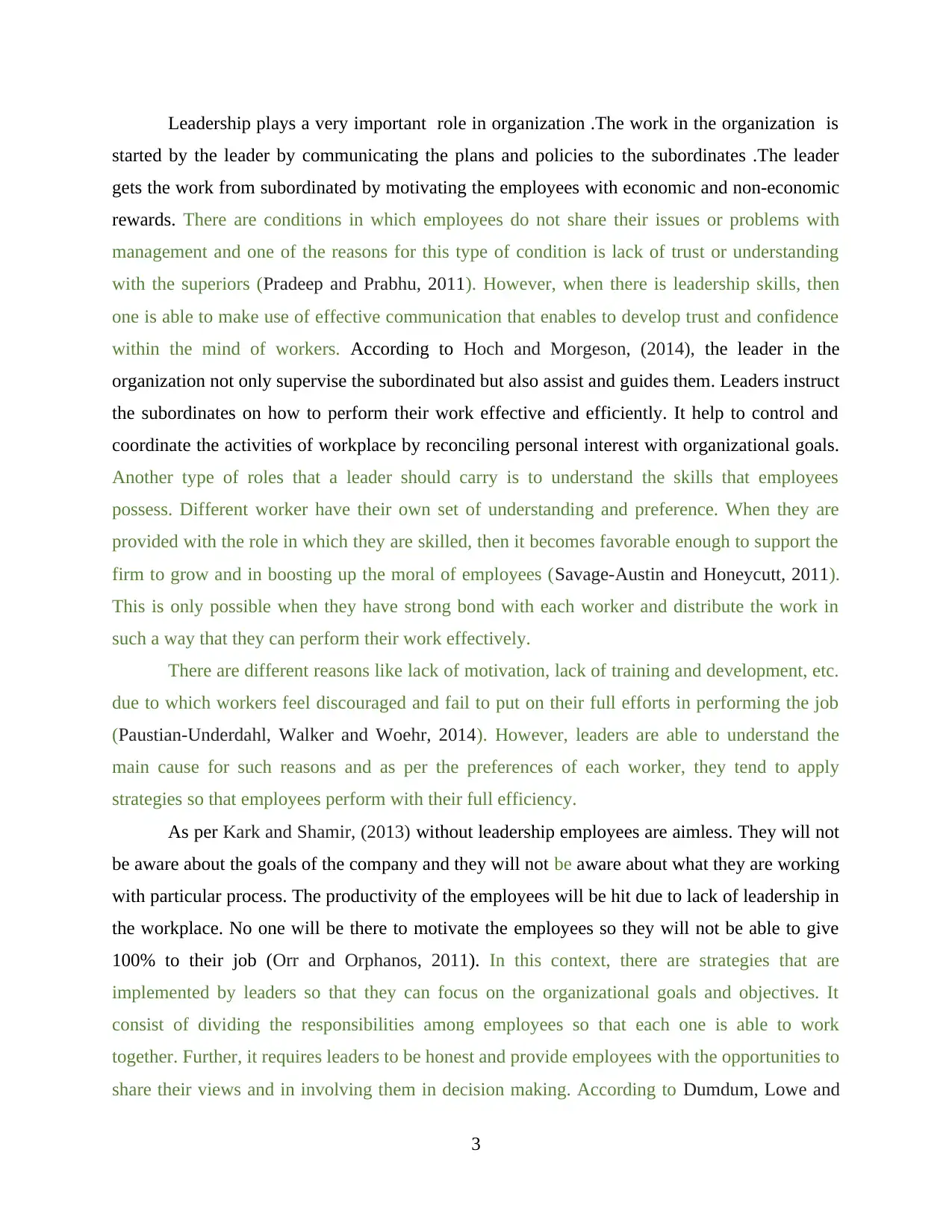
Leadership plays a very important role in organization .The work in the organization is
started by the leader by communicating the plans and policies to the subordinates .The leader
gets the work from subordinated by motivating the employees with economic and non-economic
rewards. There are conditions in which employees do not share their issues or problems with
management and one of the reasons for this type of condition is lack of trust or understanding
with the superiors (Pradeep and Prabhu, 2011). However, when there is leadership skills, then
one is able to make use of effective communication that enables to develop trust and confidence
within the mind of workers. According to Hoch and Morgeson, (2014), the leader in the
organization not only supervise the subordinated but also assist and guides them. Leaders instruct
the subordinates on how to perform their work effective and efficiently. It help to control and
coordinate the activities of workplace by reconciling personal interest with organizational goals.
Another type of roles that a leader should carry is to understand the skills that employees
possess. Different worker have their own set of understanding and preference. When they are
provided with the role in which they are skilled, then it becomes favorable enough to support the
firm to grow and in boosting up the moral of employees (Savage-Austin and Honeycutt, 2011).
This is only possible when they have strong bond with each worker and distribute the work in
such a way that they can perform their work effectively.
There are different reasons like lack of motivation, lack of training and development, etc.
due to which workers feel discouraged and fail to put on their full efforts in performing the job
(Paustian-Underdahl, Walker and Woehr, 2014). However, leaders are able to understand the
main cause for such reasons and as per the preferences of each worker, they tend to apply
strategies so that employees perform with their full efficiency.
As per Kark and Shamir, (2013) without leadership employees are aimless. They will not
be aware about the goals of the company and they will not be aware about what they are working
with particular process. The productivity of the employees will be hit due to lack of leadership in
the workplace. No one will be there to motivate the employees so they will not be able to give
100% to their job (Orr and Orphanos, 2011). In this context, there are strategies that are
implemented by leaders so that they can focus on the organizational goals and objectives. It
consist of dividing the responsibilities among employees so that each one is able to work
together. Further, it requires leaders to be honest and provide employees with the opportunities to
share their views and in involving them in decision making. According to Dumdum, Lowe and
3
started by the leader by communicating the plans and policies to the subordinates .The leader
gets the work from subordinated by motivating the employees with economic and non-economic
rewards. There are conditions in which employees do not share their issues or problems with
management and one of the reasons for this type of condition is lack of trust or understanding
with the superiors (Pradeep and Prabhu, 2011). However, when there is leadership skills, then
one is able to make use of effective communication that enables to develop trust and confidence
within the mind of workers. According to Hoch and Morgeson, (2014), the leader in the
organization not only supervise the subordinated but also assist and guides them. Leaders instruct
the subordinates on how to perform their work effective and efficiently. It help to control and
coordinate the activities of workplace by reconciling personal interest with organizational goals.
Another type of roles that a leader should carry is to understand the skills that employees
possess. Different worker have their own set of understanding and preference. When they are
provided with the role in which they are skilled, then it becomes favorable enough to support the
firm to grow and in boosting up the moral of employees (Savage-Austin and Honeycutt, 2011).
This is only possible when they have strong bond with each worker and distribute the work in
such a way that they can perform their work effectively.
There are different reasons like lack of motivation, lack of training and development, etc.
due to which workers feel discouraged and fail to put on their full efforts in performing the job
(Paustian-Underdahl, Walker and Woehr, 2014). However, leaders are able to understand the
main cause for such reasons and as per the preferences of each worker, they tend to apply
strategies so that employees perform with their full efficiency.
As per Kark and Shamir, (2013) without leadership employees are aimless. They will not
be aware about the goals of the company and they will not be aware about what they are working
with particular process. The productivity of the employees will be hit due to lack of leadership in
the workplace. No one will be there to motivate the employees so they will not be able to give
100% to their job (Orr and Orphanos, 2011). In this context, there are strategies that are
implemented by leaders so that they can focus on the organizational goals and objectives. It
consist of dividing the responsibilities among employees so that each one is able to work
together. Further, it requires leaders to be honest and provide employees with the opportunities to
share their views and in involving them in decision making. According to Dumdum, Lowe and
3
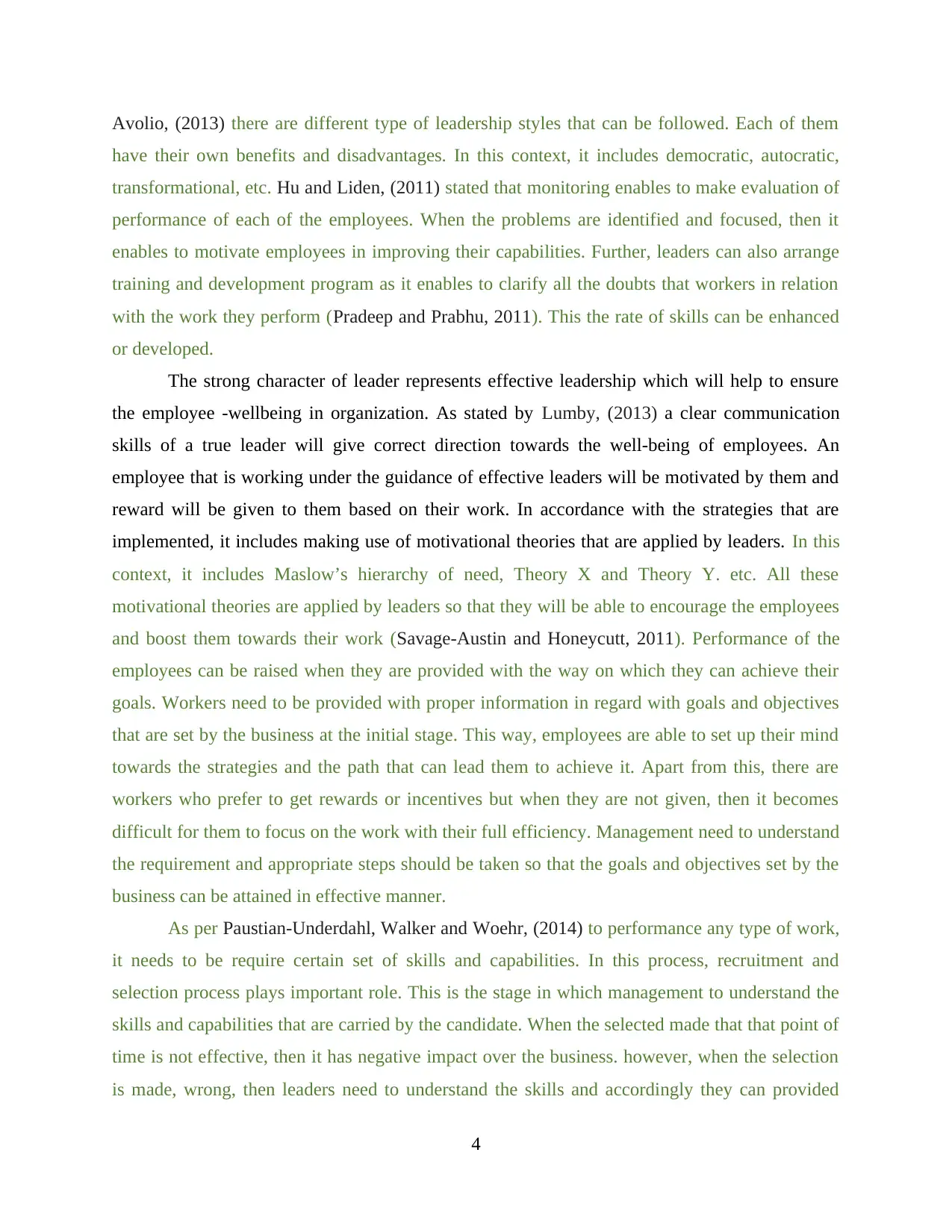
Avolio, (2013) there are different type of leadership styles that can be followed. Each of them
have their own benefits and disadvantages. In this context, it includes democratic, autocratic,
transformational, etc. Hu and Liden, (2011) stated that monitoring enables to make evaluation of
performance of each of the employees. When the problems are identified and focused, then it
enables to motivate employees in improving their capabilities. Further, leaders can also arrange
training and development program as it enables to clarify all the doubts that workers in relation
with the work they perform (Pradeep and Prabhu, 2011). This the rate of skills can be enhanced
or developed.
The strong character of leader represents effective leadership which will help to ensure
the employee -wellbeing in organization. As stated by Lumby, (2013) a clear communication
skills of a true leader will give correct direction towards the well-being of employees. An
employee that is working under the guidance of effective leaders will be motivated by them and
reward will be given to them based on their work. In accordance with the strategies that are
implemented, it includes making use of motivational theories that are applied by leaders. In this
context, it includes Maslow’s hierarchy of need, Theory X and Theory Y. etc. All these
motivational theories are applied by leaders so that they will be able to encourage the employees
and boost them towards their work (Savage-Austin and Honeycutt, 2011). Performance of the
employees can be raised when they are provided with the way on which they can achieve their
goals. Workers need to be provided with proper information in regard with goals and objectives
that are set by the business at the initial stage. This way, employees are able to set up their mind
towards the strategies and the path that can lead them to achieve it. Apart from this, there are
workers who prefer to get rewards or incentives but when they are not given, then it becomes
difficult for them to focus on the work with their full efficiency. Management need to understand
the requirement and appropriate steps should be taken so that the goals and objectives set by the
business can be attained in effective manner.
As per Paustian-Underdahl, Walker and Woehr, (2014) to performance any type of work,
it needs to be require certain set of skills and capabilities. In this process, recruitment and
selection process plays important role. This is the stage in which management to understand the
skills and capabilities that are carried by the candidate. When the selected made that that point of
time is not effective, then it has negative impact over the business. however, when the selection
is made, wrong, then leaders need to understand the skills and accordingly they can provided
4
have their own benefits and disadvantages. In this context, it includes democratic, autocratic,
transformational, etc. Hu and Liden, (2011) stated that monitoring enables to make evaluation of
performance of each of the employees. When the problems are identified and focused, then it
enables to motivate employees in improving their capabilities. Further, leaders can also arrange
training and development program as it enables to clarify all the doubts that workers in relation
with the work they perform (Pradeep and Prabhu, 2011). This the rate of skills can be enhanced
or developed.
The strong character of leader represents effective leadership which will help to ensure
the employee -wellbeing in organization. As stated by Lumby, (2013) a clear communication
skills of a true leader will give correct direction towards the well-being of employees. An
employee that is working under the guidance of effective leaders will be motivated by them and
reward will be given to them based on their work. In accordance with the strategies that are
implemented, it includes making use of motivational theories that are applied by leaders. In this
context, it includes Maslow’s hierarchy of need, Theory X and Theory Y. etc. All these
motivational theories are applied by leaders so that they will be able to encourage the employees
and boost them towards their work (Savage-Austin and Honeycutt, 2011). Performance of the
employees can be raised when they are provided with the way on which they can achieve their
goals. Workers need to be provided with proper information in regard with goals and objectives
that are set by the business at the initial stage. This way, employees are able to set up their mind
towards the strategies and the path that can lead them to achieve it. Apart from this, there are
workers who prefer to get rewards or incentives but when they are not given, then it becomes
difficult for them to focus on the work with their full efficiency. Management need to understand
the requirement and appropriate steps should be taken so that the goals and objectives set by the
business can be attained in effective manner.
As per Paustian-Underdahl, Walker and Woehr, (2014) to performance any type of work,
it needs to be require certain set of skills and capabilities. In this process, recruitment and
selection process plays important role. This is the stage in which management to understand the
skills and capabilities that are carried by the candidate. When the selected made that that point of
time is not effective, then it has negative impact over the business. however, when the selection
is made, wrong, then leaders need to understand the skills and accordingly they can provided
4
⊘ This is a preview!⊘
Do you want full access?
Subscribe today to unlock all pages.

Trusted by 1+ million students worldwide
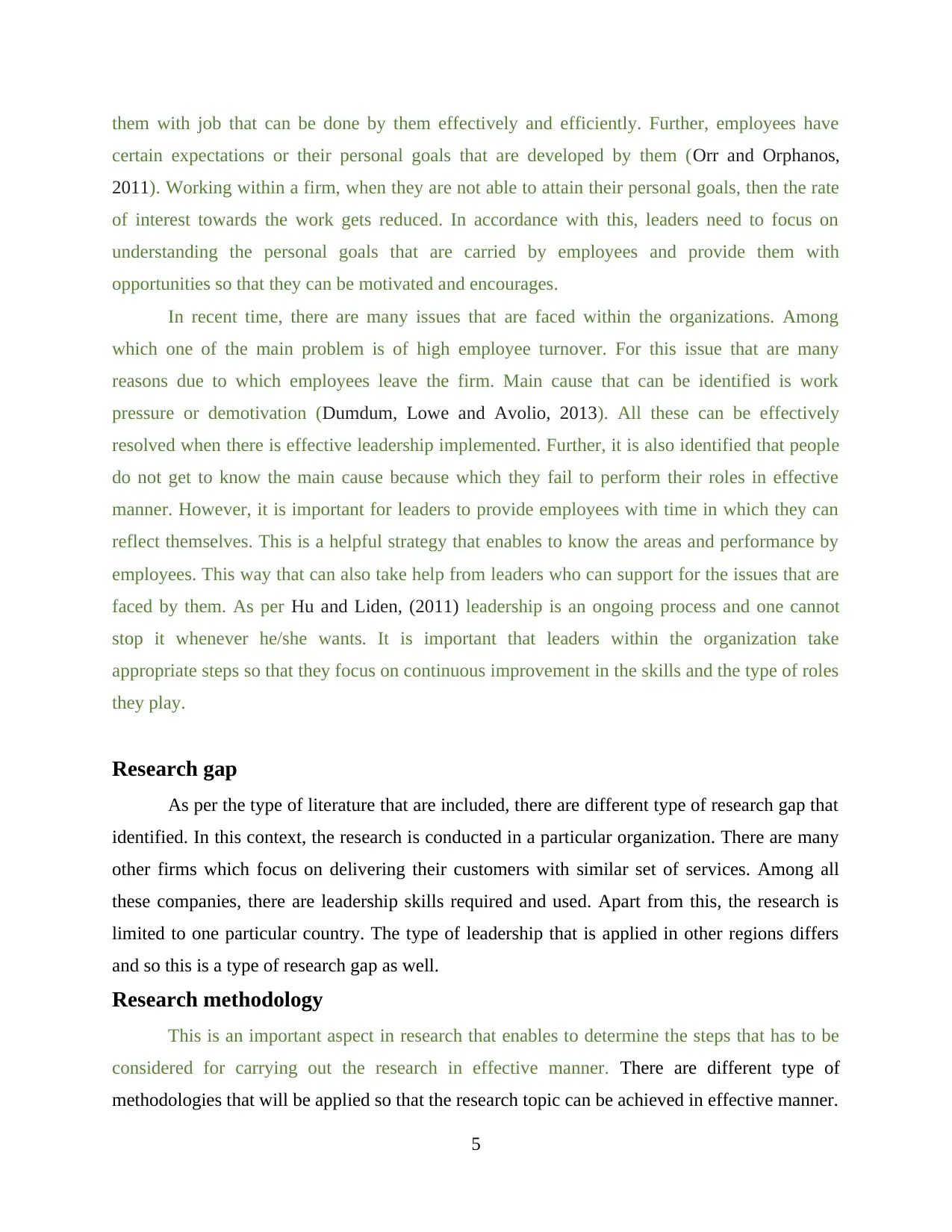
them with job that can be done by them effectively and efficiently. Further, employees have
certain expectations or their personal goals that are developed by them (Orr and Orphanos,
2011). Working within a firm, when they are not able to attain their personal goals, then the rate
of interest towards the work gets reduced. In accordance with this, leaders need to focus on
understanding the personal goals that are carried by employees and provide them with
opportunities so that they can be motivated and encourages.
In recent time, there are many issues that are faced within the organizations. Among
which one of the main problem is of high employee turnover. For this issue that are many
reasons due to which employees leave the firm. Main cause that can be identified is work
pressure or demotivation (Dumdum, Lowe and Avolio, 2013). All these can be effectively
resolved when there is effective leadership implemented. Further, it is also identified that people
do not get to know the main cause because which they fail to perform their roles in effective
manner. However, it is important for leaders to provide employees with time in which they can
reflect themselves. This is a helpful strategy that enables to know the areas and performance by
employees. This way that can also take help from leaders who can support for the issues that are
faced by them. As per Hu and Liden, (2011) leadership is an ongoing process and one cannot
stop it whenever he/she wants. It is important that leaders within the organization take
appropriate steps so that they focus on continuous improvement in the skills and the type of roles
they play.
Research gap
As per the type of literature that are included, there are different type of research gap that
identified. In this context, the research is conducted in a particular organization. There are many
other firms which focus on delivering their customers with similar set of services. Among all
these companies, there are leadership skills required and used. Apart from this, the research is
limited to one particular country. The type of leadership that is applied in other regions differs
and so this is a type of research gap as well.
Research methodology
This is an important aspect in research that enables to determine the steps that has to be
considered for carrying out the research in effective manner. There are different type of
methodologies that will be applied so that the research topic can be achieved in effective manner.
5
certain expectations or their personal goals that are developed by them (Orr and Orphanos,
2011). Working within a firm, when they are not able to attain their personal goals, then the rate
of interest towards the work gets reduced. In accordance with this, leaders need to focus on
understanding the personal goals that are carried by employees and provide them with
opportunities so that they can be motivated and encourages.
In recent time, there are many issues that are faced within the organizations. Among
which one of the main problem is of high employee turnover. For this issue that are many
reasons due to which employees leave the firm. Main cause that can be identified is work
pressure or demotivation (Dumdum, Lowe and Avolio, 2013). All these can be effectively
resolved when there is effective leadership implemented. Further, it is also identified that people
do not get to know the main cause because which they fail to perform their roles in effective
manner. However, it is important for leaders to provide employees with time in which they can
reflect themselves. This is a helpful strategy that enables to know the areas and performance by
employees. This way that can also take help from leaders who can support for the issues that are
faced by them. As per Hu and Liden, (2011) leadership is an ongoing process and one cannot
stop it whenever he/she wants. It is important that leaders within the organization take
appropriate steps so that they focus on continuous improvement in the skills and the type of roles
they play.
Research gap
As per the type of literature that are included, there are different type of research gap that
identified. In this context, the research is conducted in a particular organization. There are many
other firms which focus on delivering their customers with similar set of services. Among all
these companies, there are leadership skills required and used. Apart from this, the research is
limited to one particular country. The type of leadership that is applied in other regions differs
and so this is a type of research gap as well.
Research methodology
This is an important aspect in research that enables to determine the steps that has to be
considered for carrying out the research in effective manner. There are different type of
methodologies that will be applied so that the research topic can be achieved in effective manner.
5
Paraphrase This Document
Need a fresh take? Get an instant paraphrase of this document with our AI Paraphraser
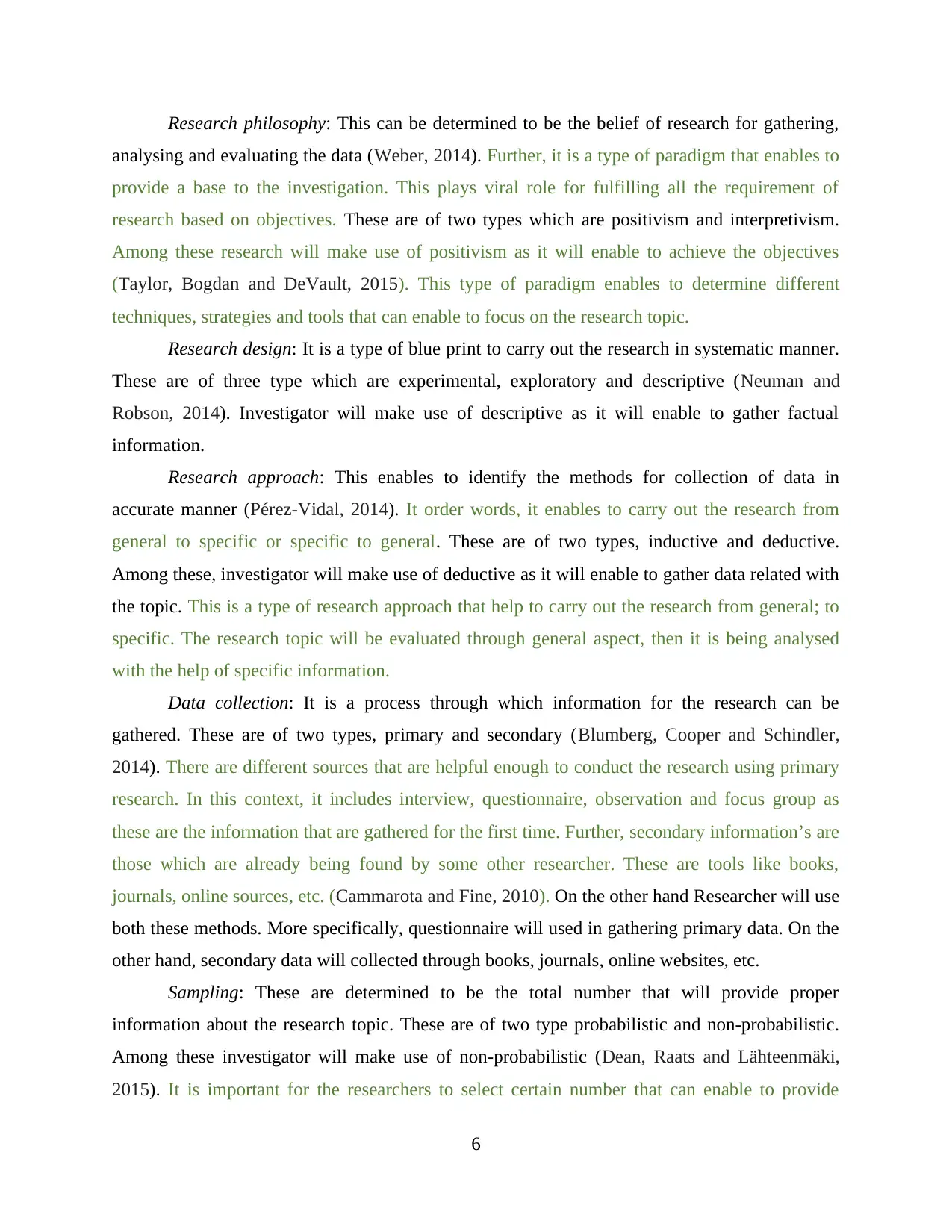
Research philosophy: This can be determined to be the belief of research for gathering,
analysing and evaluating the data (Weber, 2014). Further, it is a type of paradigm that enables to
provide a base to the investigation. This plays viral role for fulfilling all the requirement of
research based on objectives. These are of two types which are positivism and interpretivism.
Among these research will make use of positivism as it will enable to achieve the objectives
(Taylor, Bogdan and DeVault, 2015). This type of paradigm enables to determine different
techniques, strategies and tools that can enable to focus on the research topic.
Research design: It is a type of blue print to carry out the research in systematic manner.
These are of three type which are experimental, exploratory and descriptive (Neuman and
Robson, 2014). Investigator will make use of descriptive as it will enable to gather factual
information.
Research approach: This enables to identify the methods for collection of data in
accurate manner (Pérez-Vidal, 2014). It order words, it enables to carry out the research from
general to specific or specific to general. These are of two types, inductive and deductive.
Among these, investigator will make use of deductive as it will enable to gather data related with
the topic. This is a type of research approach that help to carry out the research from general; to
specific. The research topic will be evaluated through general aspect, then it is being analysed
with the help of specific information.
Data collection: It is a process through which information for the research can be
gathered. These are of two types, primary and secondary (Blumberg, Cooper and Schindler,
2014). There are different sources that are helpful enough to conduct the research using primary
research. In this context, it includes interview, questionnaire, observation and focus group as
these are the information that are gathered for the first time. Further, secondary information’s are
those which are already being found by some other researcher. These are tools like books,
journals, online sources, etc. (Cammarota and Fine, 2010). On the other hand Researcher will use
both these methods. More specifically, questionnaire will used in gathering primary data. On the
other hand, secondary data will collected through books, journals, online websites, etc.
Sampling: These are determined to be the total number that will provide proper
information about the research topic. These are of two type probabilistic and non-probabilistic.
Among these investigator will make use of non-probabilistic (Dean, Raats and Lähteenmäki,
2015). It is important for the researchers to select certain number that can enable to provide
6
analysing and evaluating the data (Weber, 2014). Further, it is a type of paradigm that enables to
provide a base to the investigation. This plays viral role for fulfilling all the requirement of
research based on objectives. These are of two types which are positivism and interpretivism.
Among these research will make use of positivism as it will enable to achieve the objectives
(Taylor, Bogdan and DeVault, 2015). This type of paradigm enables to determine different
techniques, strategies and tools that can enable to focus on the research topic.
Research design: It is a type of blue print to carry out the research in systematic manner.
These are of three type which are experimental, exploratory and descriptive (Neuman and
Robson, 2014). Investigator will make use of descriptive as it will enable to gather factual
information.
Research approach: This enables to identify the methods for collection of data in
accurate manner (Pérez-Vidal, 2014). It order words, it enables to carry out the research from
general to specific or specific to general. These are of two types, inductive and deductive.
Among these, investigator will make use of deductive as it will enable to gather data related with
the topic. This is a type of research approach that help to carry out the research from general; to
specific. The research topic will be evaluated through general aspect, then it is being analysed
with the help of specific information.
Data collection: It is a process through which information for the research can be
gathered. These are of two types, primary and secondary (Blumberg, Cooper and Schindler,
2014). There are different sources that are helpful enough to conduct the research using primary
research. In this context, it includes interview, questionnaire, observation and focus group as
these are the information that are gathered for the first time. Further, secondary information’s are
those which are already being found by some other researcher. These are tools like books,
journals, online sources, etc. (Cammarota and Fine, 2010). On the other hand Researcher will use
both these methods. More specifically, questionnaire will used in gathering primary data. On the
other hand, secondary data will collected through books, journals, online websites, etc.
Sampling: These are determined to be the total number that will provide proper
information about the research topic. These are of two type probabilistic and non-probabilistic.
Among these investigator will make use of non-probabilistic (Dean, Raats and Lähteenmäki,
2015). It is important for the researchers to select certain number that can enable to provide
6
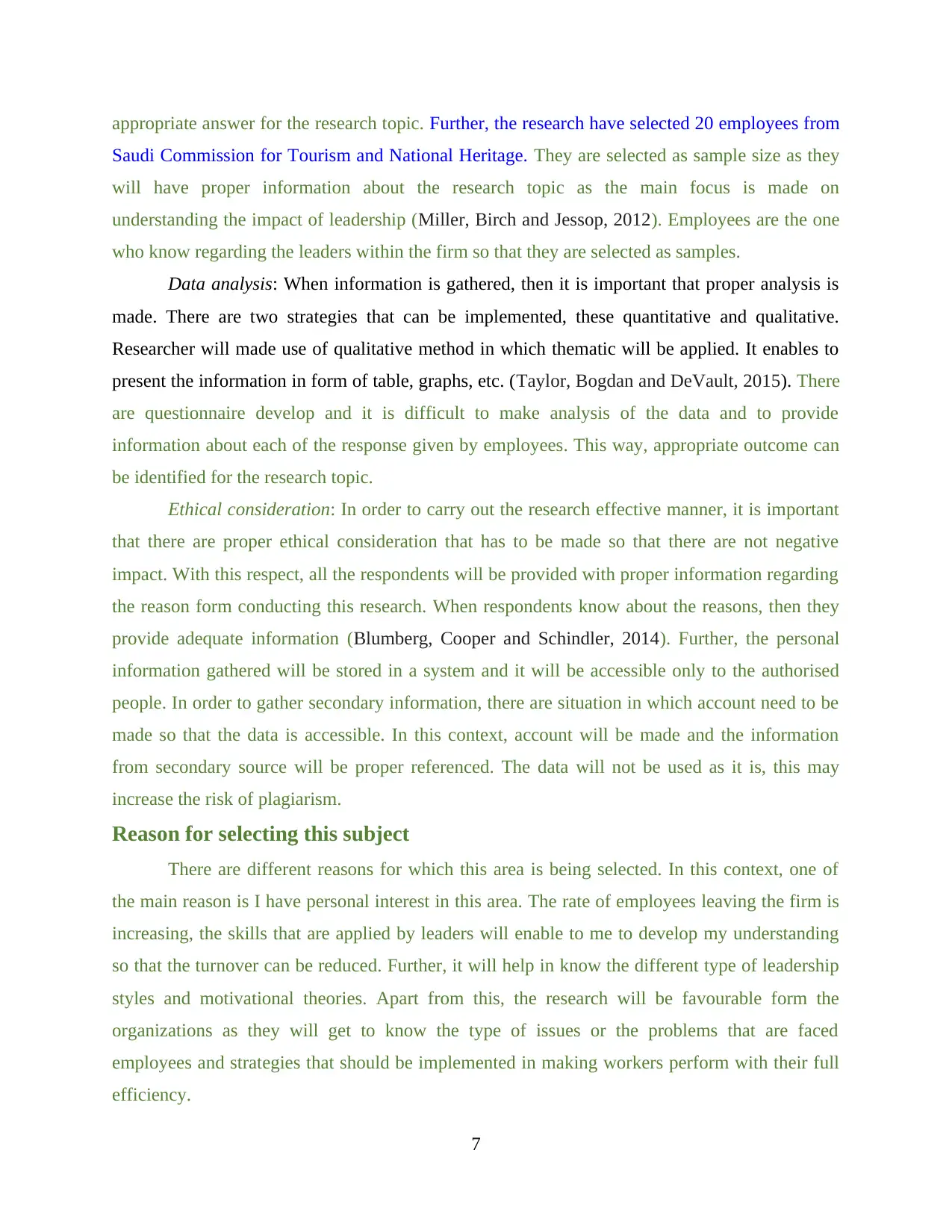
appropriate answer for the research topic. Further, the research have selected 20 employees from
Saudi Commission for Tourism and National Heritage. They are selected as sample size as they
will have proper information about the research topic as the main focus is made on
understanding the impact of leadership (Miller, Birch and Jessop, 2012). Employees are the one
who know regarding the leaders within the firm so that they are selected as samples.
Data analysis: When information is gathered, then it is important that proper analysis is
made. There are two strategies that can be implemented, these quantitative and qualitative.
Researcher will made use of qualitative method in which thematic will be applied. It enables to
present the information in form of table, graphs, etc. (Taylor, Bogdan and DeVault, 2015). There
are questionnaire develop and it is difficult to make analysis of the data and to provide
information about each of the response given by employees. This way, appropriate outcome can
be identified for the research topic.
Ethical consideration: In order to carry out the research effective manner, it is important
that there are proper ethical consideration that has to be made so that there are not negative
impact. With this respect, all the respondents will be provided with proper information regarding
the reason form conducting this research. When respondents know about the reasons, then they
provide adequate information (Blumberg, Cooper and Schindler, 2014). Further, the personal
information gathered will be stored in a system and it will be accessible only to the authorised
people. In order to gather secondary information, there are situation in which account need to be
made so that the data is accessible. In this context, account will be made and the information
from secondary source will be proper referenced. The data will not be used as it is, this may
increase the risk of plagiarism.
Reason for selecting this subject
There are different reasons for which this area is being selected. In this context, one of
the main reason is I have personal interest in this area. The rate of employees leaving the firm is
increasing, the skills that are applied by leaders will enable to me to develop my understanding
so that the turnover can be reduced. Further, it will help in know the different type of leadership
styles and motivational theories. Apart from this, the research will be favourable form the
organizations as they will get to know the type of issues or the problems that are faced
employees and strategies that should be implemented in making workers perform with their full
efficiency.
7
Saudi Commission for Tourism and National Heritage. They are selected as sample size as they
will have proper information about the research topic as the main focus is made on
understanding the impact of leadership (Miller, Birch and Jessop, 2012). Employees are the one
who know regarding the leaders within the firm so that they are selected as samples.
Data analysis: When information is gathered, then it is important that proper analysis is
made. There are two strategies that can be implemented, these quantitative and qualitative.
Researcher will made use of qualitative method in which thematic will be applied. It enables to
present the information in form of table, graphs, etc. (Taylor, Bogdan and DeVault, 2015). There
are questionnaire develop and it is difficult to make analysis of the data and to provide
information about each of the response given by employees. This way, appropriate outcome can
be identified for the research topic.
Ethical consideration: In order to carry out the research effective manner, it is important
that there are proper ethical consideration that has to be made so that there are not negative
impact. With this respect, all the respondents will be provided with proper information regarding
the reason form conducting this research. When respondents know about the reasons, then they
provide adequate information (Blumberg, Cooper and Schindler, 2014). Further, the personal
information gathered will be stored in a system and it will be accessible only to the authorised
people. In order to gather secondary information, there are situation in which account need to be
made so that the data is accessible. In this context, account will be made and the information
from secondary source will be proper referenced. The data will not be used as it is, this may
increase the risk of plagiarism.
Reason for selecting this subject
There are different reasons for which this area is being selected. In this context, one of
the main reason is I have personal interest in this area. The rate of employees leaving the firm is
increasing, the skills that are applied by leaders will enable to me to develop my understanding
so that the turnover can be reduced. Further, it will help in know the different type of leadership
styles and motivational theories. Apart from this, the research will be favourable form the
organizations as they will get to know the type of issues or the problems that are faced
employees and strategies that should be implemented in making workers perform with their full
efficiency.
7
⊘ This is a preview!⊘
Do you want full access?
Subscribe today to unlock all pages.

Trusted by 1+ million students worldwide
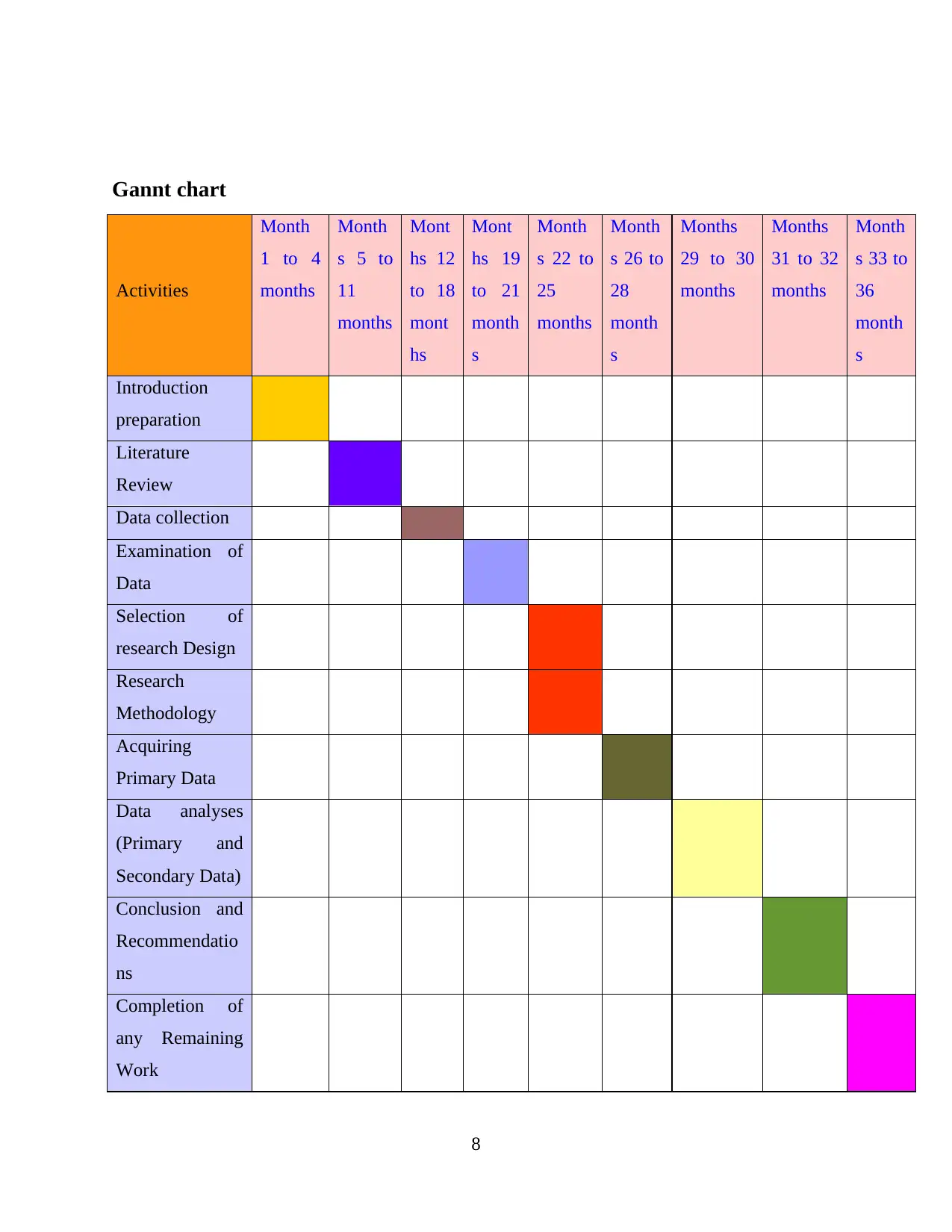
Gannt chart
Activities
Month
1 to 4
months
Month
s 5 to
11
months
Mont
hs 12
to 18
mont
hs
Mont
hs 19
to 21
month
s
Month
s 22 to
25
months
Month
s 26 to
28
month
s
Months
29 to 30
months
Months
31 to 32
months
Month
s 33 to
36
month
s
Introduction
preparation
Literature
Review
Data collection
Examination of
Data
Selection of
research Design
Research
Methodology
Acquiring
Primary Data
Data analyses
(Primary and
Secondary Data)
Conclusion and
Recommendatio
ns
Completion of
any Remaining
Work
8
Activities
Month
1 to 4
months
Month
s 5 to
11
months
Mont
hs 12
to 18
mont
hs
Mont
hs 19
to 21
month
s
Month
s 22 to
25
months
Month
s 26 to
28
month
s
Months
29 to 30
months
Months
31 to 32
months
Month
s 33 to
36
month
s
Introduction
preparation
Literature
Review
Data collection
Examination of
Data
Selection of
research Design
Research
Methodology
Acquiring
Primary Data
Data analyses
(Primary and
Secondary Data)
Conclusion and
Recommendatio
ns
Completion of
any Remaining
Work
8
Paraphrase This Document
Need a fresh take? Get an instant paraphrase of this document with our AI Paraphraser
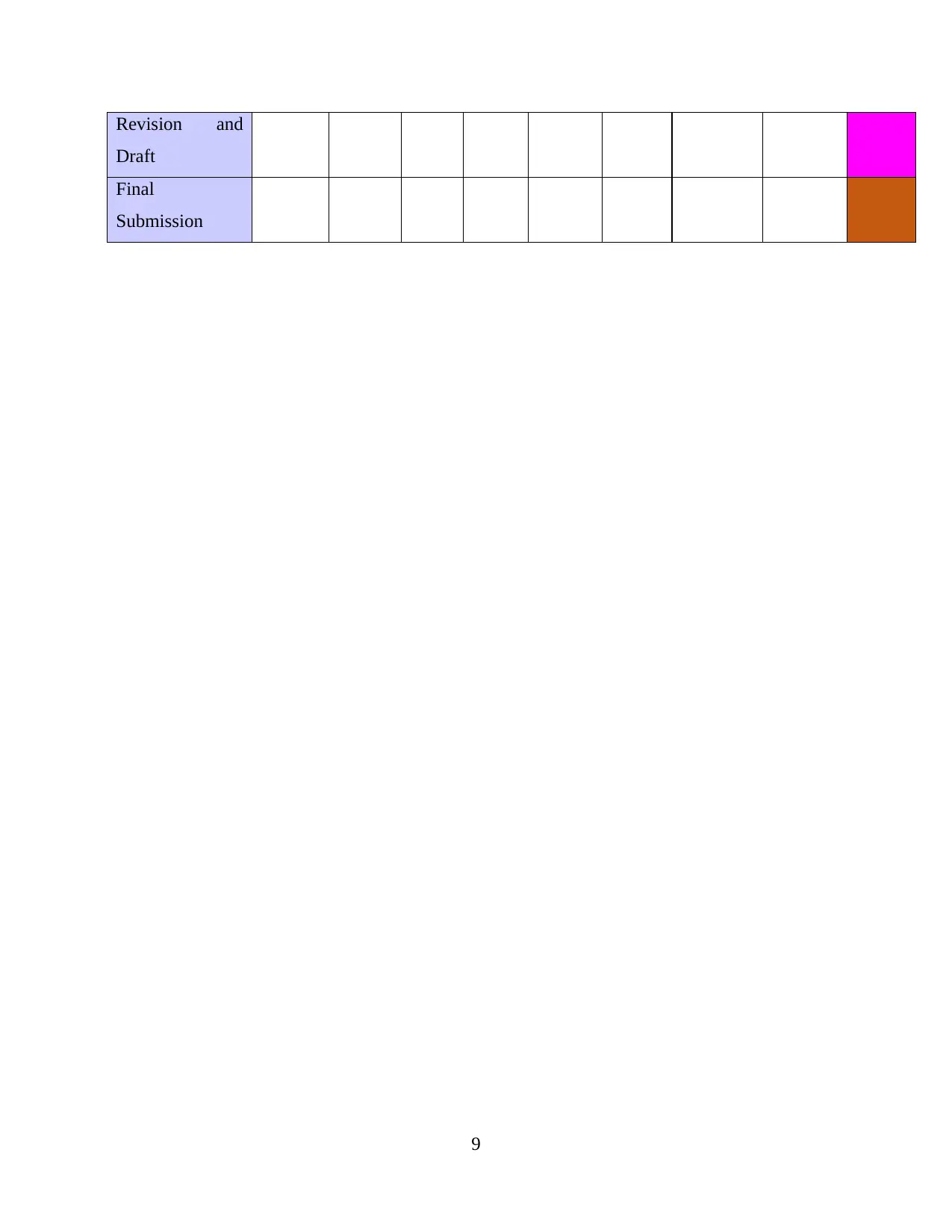
Revision and
Draft
Final
Submission
9
Draft
Final
Submission
9
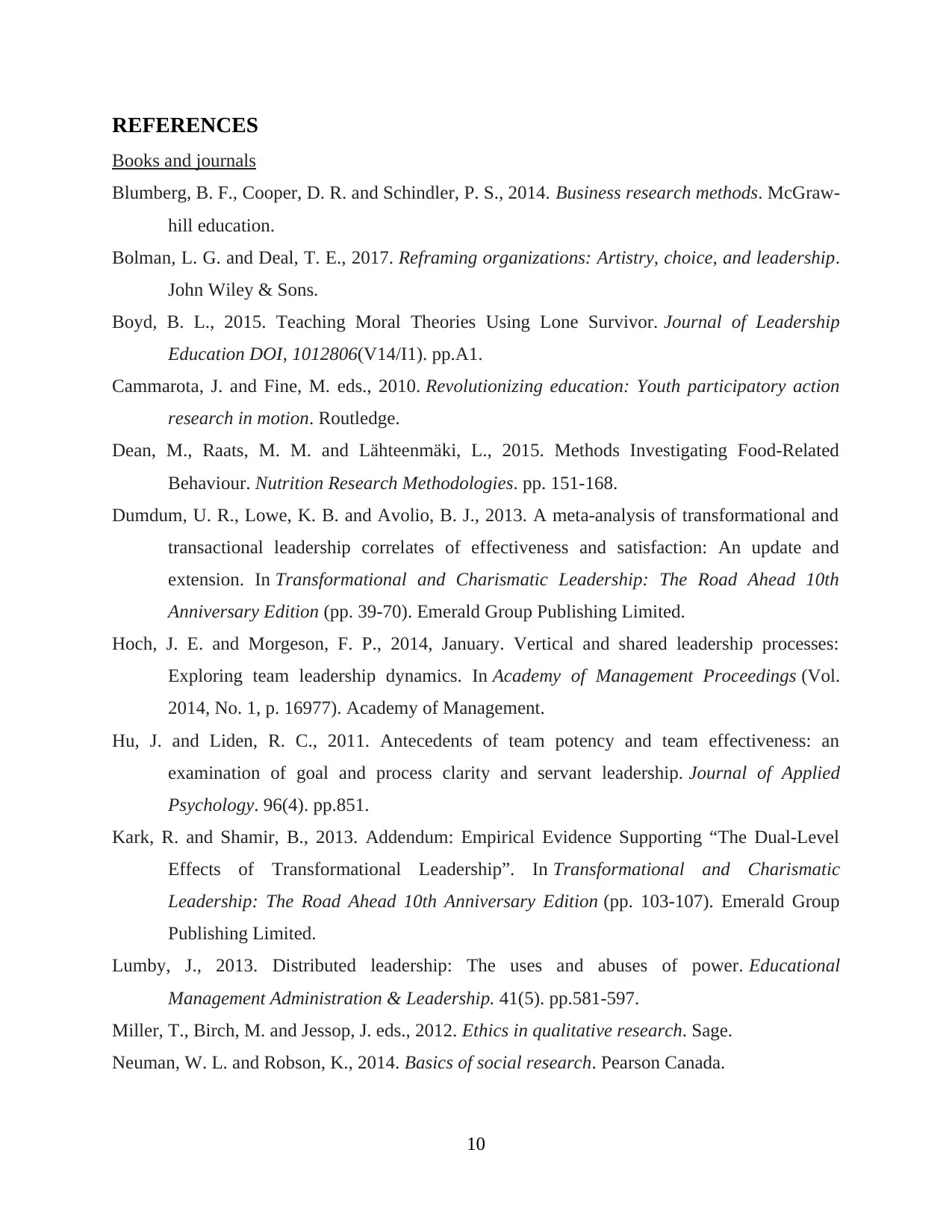
REFERENCES
Books and journals
Blumberg, B. F., Cooper, D. R. and Schindler, P. S., 2014. Business research methods. McGraw-
hill education.
Bolman, L. G. and Deal, T. E., 2017. Reframing organizations: Artistry, choice, and leadership.
John Wiley & Sons.
Boyd, B. L., 2015. Teaching Moral Theories Using Lone Survivor. Journal of Leadership
Education DOI, 1012806(V14/I1). pp.A1.
Cammarota, J. and Fine, M. eds., 2010. Revolutionizing education: Youth participatory action
research in motion. Routledge.
Dean, M., Raats, M. M. and Lähteenmäki, L., 2015. Methods Investigating Food‐Related
Behaviour. Nutrition Research Methodologies. pp. 151-168.
Dumdum, U. R., Lowe, K. B. and Avolio, B. J., 2013. A meta-analysis of transformational and
transactional leadership correlates of effectiveness and satisfaction: An update and
extension. In Transformational and Charismatic Leadership: The Road Ahead 10th
Anniversary Edition (pp. 39-70). Emerald Group Publishing Limited.
Hoch, J. E. and Morgeson, F. P., 2014, January. Vertical and shared leadership processes:
Exploring team leadership dynamics. In Academy of Management Proceedings (Vol.
2014, No. 1, p. 16977). Academy of Management.
Hu, J. and Liden, R. C., 2011. Antecedents of team potency and team effectiveness: an
examination of goal and process clarity and servant leadership. Journal of Applied
Psychology. 96(4). pp.851.
Kark, R. and Shamir, B., 2013. Addendum: Empirical Evidence Supporting “The Dual-Level
Effects of Transformational Leadership”. In Transformational and Charismatic
Leadership: The Road Ahead 10th Anniversary Edition (pp. 103-107). Emerald Group
Publishing Limited.
Lumby, J., 2013. Distributed leadership: The uses and abuses of power. Educational
Management Administration & Leadership. 41(5). pp.581-597.
Miller, T., Birch, M. and Jessop, J. eds., 2012. Ethics in qualitative research. Sage.
Neuman, W. L. and Robson, K., 2014. Basics of social research. Pearson Canada.
10
Books and journals
Blumberg, B. F., Cooper, D. R. and Schindler, P. S., 2014. Business research methods. McGraw-
hill education.
Bolman, L. G. and Deal, T. E., 2017. Reframing organizations: Artistry, choice, and leadership.
John Wiley & Sons.
Boyd, B. L., 2015. Teaching Moral Theories Using Lone Survivor. Journal of Leadership
Education DOI, 1012806(V14/I1). pp.A1.
Cammarota, J. and Fine, M. eds., 2010. Revolutionizing education: Youth participatory action
research in motion. Routledge.
Dean, M., Raats, M. M. and Lähteenmäki, L., 2015. Methods Investigating Food‐Related
Behaviour. Nutrition Research Methodologies. pp. 151-168.
Dumdum, U. R., Lowe, K. B. and Avolio, B. J., 2013. A meta-analysis of transformational and
transactional leadership correlates of effectiveness and satisfaction: An update and
extension. In Transformational and Charismatic Leadership: The Road Ahead 10th
Anniversary Edition (pp. 39-70). Emerald Group Publishing Limited.
Hoch, J. E. and Morgeson, F. P., 2014, January. Vertical and shared leadership processes:
Exploring team leadership dynamics. In Academy of Management Proceedings (Vol.
2014, No. 1, p. 16977). Academy of Management.
Hu, J. and Liden, R. C., 2011. Antecedents of team potency and team effectiveness: an
examination of goal and process clarity and servant leadership. Journal of Applied
Psychology. 96(4). pp.851.
Kark, R. and Shamir, B., 2013. Addendum: Empirical Evidence Supporting “The Dual-Level
Effects of Transformational Leadership”. In Transformational and Charismatic
Leadership: The Road Ahead 10th Anniversary Edition (pp. 103-107). Emerald Group
Publishing Limited.
Lumby, J., 2013. Distributed leadership: The uses and abuses of power. Educational
Management Administration & Leadership. 41(5). pp.581-597.
Miller, T., Birch, M. and Jessop, J. eds., 2012. Ethics in qualitative research. Sage.
Neuman, W. L. and Robson, K., 2014. Basics of social research. Pearson Canada.
10
⊘ This is a preview!⊘
Do you want full access?
Subscribe today to unlock all pages.

Trusted by 1+ million students worldwide
1 out of 14
Related Documents
Your All-in-One AI-Powered Toolkit for Academic Success.
+13062052269
info@desklib.com
Available 24*7 on WhatsApp / Email
![[object Object]](/_next/static/media/star-bottom.7253800d.svg)
Unlock your academic potential
Copyright © 2020–2025 A2Z Services. All Rights Reserved. Developed and managed by ZUCOL.





